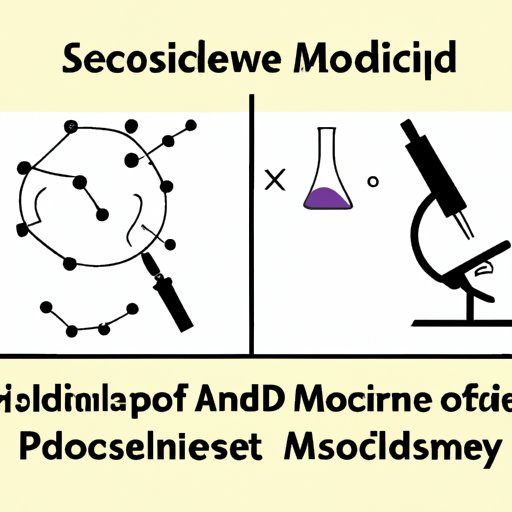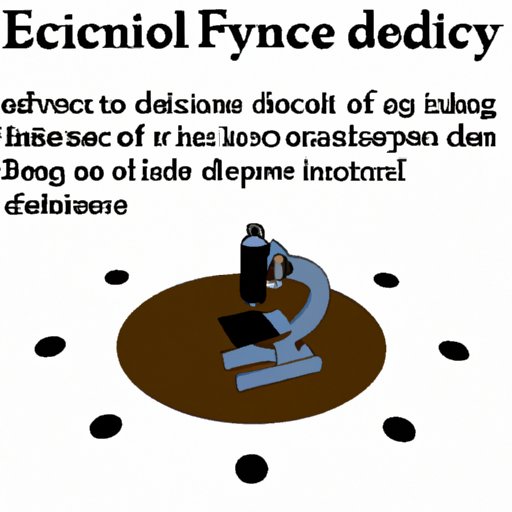Introduction
Science and pseudoscience are two concepts that often get confused and intertwined, but they are actually quite different. Science is a systematic and objective approach to understanding the natural world, while pseudoscience is based on claims that appear to be scientific but lack any real evidence to support them. In this article, we will explore the differences between science and pseudoscience in terms of defining characteristics, approaches, and standards of evidence.
Exploring the Contrasts: Examining the Difference between Science and Pseudoscience
In order to understand the difference between science and pseudoscience, it is important to first define each term. Science is defined as “a systematic enterprise that builds and organizes knowledge in the form of testable explanations and predictions about the universe.” 1 Pseudoscience, on the other hand, is defined as “claims presented so that they appear to be scientific even though they lack supporting evidence or plausibility.” 2 With these definitions in mind, let’s examine the defining characteristics of both science and pseudoscience.
Defining Characteristics of Science
Science is characterized by its reliance on the scientific method, which is a process of observation, hypothesis generation, experimentation, and data analysis. This method is used to systematically investigate phenomena and develop theories that can explain those phenomena. Additionally, science relies on the use of empirical evidence, meaning evidence that has been observed or measured directly. Finally, science values logic and reason, meaning that theories must make sense and be consistent with existing evidence.
Defining Characteristics of Pseudoscience
Pseudoscience is characterized by its reliance on untested and unverifiable claims. These claims may appear to be scientific, but they lack any real evidence to support them. Additionally, pseudoscience often relies on anecdotal evidence, meaning evidence that is based on personal stories rather than direct observation or measurement. Finally, pseudoscience often relies on logical fallacies, meaning arguments that seem to make sense but are actually flawed in some way.
A Comparison of Science and Pseudoscience: What Makes Them Unique?
Now that we have examined the defining characteristics of both science and pseudoscience, let’s take a look at how they differ from one another in terms of their approaches and standards of evidence.
Scientific Method
The scientific method is a process of observation, hypothesis generation, experimentation, and data analysis that is used to systematically investigate phenomena and develop theories that can explain those phenomena. This method is the cornerstone of science and is used to evaluate claims and determine if they are true or false.
Standards of Evidence
Science relies on empirical evidence, meaning evidence that has been observed or measured directly. Pseudoscience, on the other hand, often relies on anecdotal evidence, meaning evidence that is based on personal stories rather than direct observation or measurement. Additionally, science values logic and reason, meaning that theories must make sense and be consistent with existing evidence, while pseudoscience often relies on logical fallacies, meaning arguments that seem to make sense but are actually flawed in some way.
Logic and Reasoning
Science values logic and reason, meaning that theories must make sense and be consistent with existing evidence. Pseudoscience often relies on logical fallacies, meaning arguments that seem to make sense but are actually flawed in some way. Additionally, science relies on empirical evidence, meaning evidence that has been observed or measured directly, while pseudoscience often relies on anecdotal evidence, meaning evidence that is based on personal stories rather than direct observation or measurement.

Debunking Pseudoscience: Separating Fact from Fiction
When evaluating claims, it is important to be able to identify pseudoscience and separate fact from fiction. To do this, it is important to analyze claims critically and objectively, identify logical fallacies, and expose misleading information. Additionally, it is important to be aware of the limitations of scientific knowledge and recognize when there is not enough evidence to draw conclusions.

The Scientific Method vs. Pseudoscience: Analyzing Their Different Approaches
The scientific method is a process of observation, hypothesis generation, experimentation, and data analysis that is used to systematically investigate phenomena and develop theories that can explain those phenomena. Pseudoscience, however, does not rely on the scientific method and instead relies on untested and unverifiable claims that may appear to be scientific but lack any real evidence to support them.
Uncovering the Truth: Comparing Science to Pseudoscience
In order to uncover the truth, it is important to compare the approaches and standards of evidence used by science and pseudoscience. When testing hypotheses, science relies on empirical evidence and logic and reason, while pseudoscience relies on anecdotal evidence and logical fallacies. When gathering data, science relies on rigorous methods and peer review, while pseudoscience relies on biased sources and unreliable data. Finally, when validating results, science relies on replication and accuracy, while pseudoscience relies on unsupported claims and misleading information.

Setting the Record Straight: How Science Differs from Pseudoscience
Science differs from pseudoscience in several key ways. First, science relies on the scientific method to systematically investigate phenomena and develop theories that can explain those phenomena, while pseudoscience does not rely on the scientific method and instead relies on untested and unverifiable claims. Second, science relies on empirical evidence, logic, and reason to test hypotheses, while pseudoscience relies on anecdotal evidence and logical fallacies. Third, science relies on rigorous methods and peer review to gather data, while pseudoscience relies on biased sources and unreliable data. Finally, science relies on replication and accuracy to validate results, while pseudoscience relies on unsupported claims and misleading information.
Investigating the Unfamiliar: Understanding Science and Pseudoscience
In order to understand the difference between science and pseudoscience, it is important to investigate the unfamiliar. This means taking the time to evaluate claims critically and objectively, identify logical fallacies, and expose misleading information. Additionally, it is important to remain open to new ideas and respect evidence, no matter where it comes from. By doing this, we can gain a better understanding of the world around us and separate fact from fiction.
Conclusion
In conclusion, science and pseudoscience are two distinct concepts that differ in terms of defining characteristics, approaches, and standards of evidence. Science relies on the scientific method, empirical evidence, and logic and reason, while pseudoscience relies on untested and unverifiable claims, anecdotal evidence, and logical fallacies. By critically examining claims and separating fact from fiction, we can gain a better understanding of the world around us and uncover the truth.
If you would like to learn more about the differences between science and pseudoscience, there are many resources available online. The National Science Foundation offers an overview of the scientific process, the American Association for the Advancement of Science provides information on scientific skepticism, and the Skeptical Inquirer magazine features articles on debunking pseudoscience.
Summary of Contrasts
This article examined the differences between science and pseudoscience in terms of defining characteristics, approaches, and standards of evidence. Science relies on the scientific method, empirical evidence, and logic and reason, while pseudoscience relies on untested and unverifiable claims, anecdotal evidence, and logical fallacies. Additionally, science values rigorous evaluation, openness to new ideas, and respect for evidence, while pseudoscience relies on unsupported claims and misleading information.
Final Thoughts
Understanding the difference between science and pseudoscience is essential in today’s world. By critically examining claims and separating fact from fiction, we can gain a better understanding of the world around us and uncover the truth.
(Note: Is this article not meeting your expectations? Do you have knowledge or insights to share? Unlock new opportunities and expand your reach by joining our authors team. Click Registration to join us and share your expertise with our readers.)
